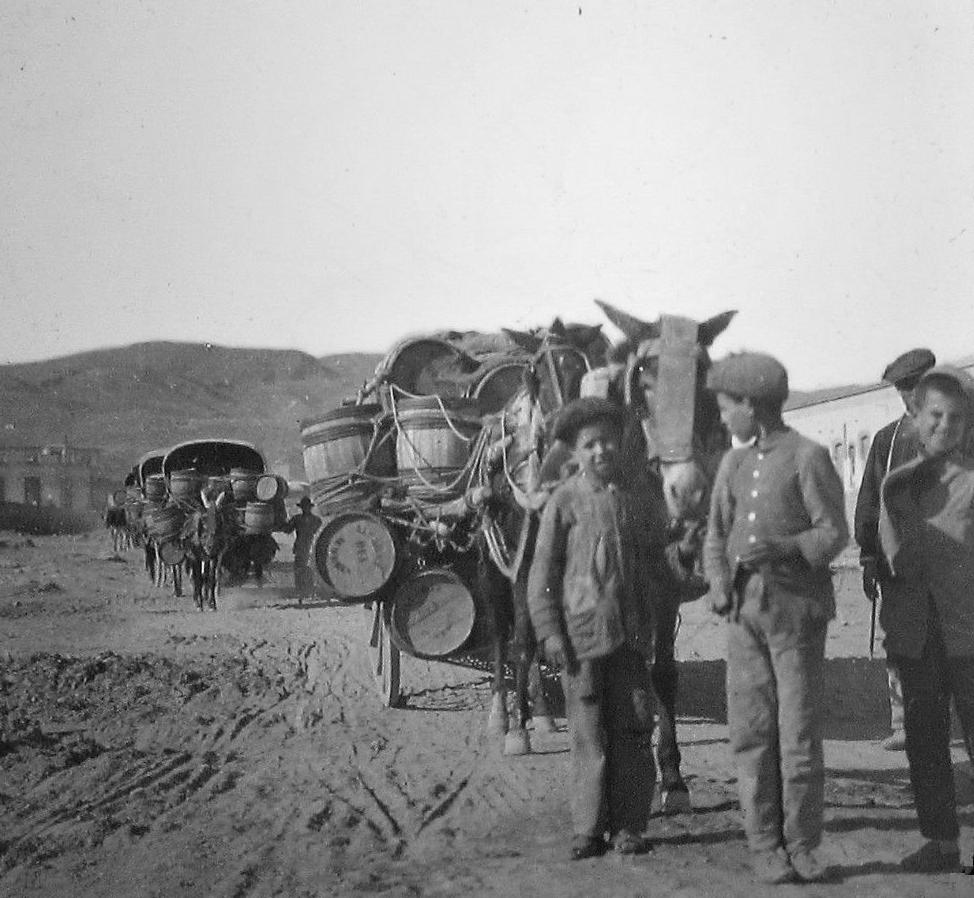
Mode of Travel and Transport: Beasts of Burden

Figure 1.--The use of beats of burden in transoport was important for millennia and extended well into the 20th cenntury. America was the first country to make the shift to the internal combustion engine power in cars and trucks. Beasts of burden ciontinued to be important in Europe as late as World War II (1939-45). Other areas (Asia, Africa, and Latin America) lagged even further. Here during the 1900s we see mules bringing waggons carrying barrels into town (Almeria). This is the Andalusian area of Spain. Source:
Studio: Keystone View Co.
|
|
There is good reason why cars and trucks are rated in horsepower. Cars have been with us just a little more than a century. Horses and other beasts of burden have been with us for millenia. Infact civikization itself could not develop fuly without them. As horses and other large animals were domesticated, transport of goods over long distances became possible. The first caravans were donkey caavans. The donkey was the first somesticated beast of burden. The donkey is, however a small animal which limited the the loads which could be transported. And donkeys required food and water, limiting movement--especially across desert areas. Mountains also created barriers. The deserts were finally breeched with the domestication of the cammel. Caravan trains crossed the trackless plains and deserts of Central Asia. The costs were enormous. The caravan track accross Central Asia was called the Silk Road because it brought silk and other valuable Chinese products to Europe. Romans and subsequent Europeans coveted silk, but for centuries Chinese emperors retained the secret of silk production as a state secret. While commerce was conducted through caravans this was a extremely expensive way of conducting commerce. And pasage through political jurisdictions also meant added costs. Thus the cost of goods trnsported over the silk Road were astronomical. The importance of this transport mode should not be discounted as inefficent as uit was. The lack of beasts of burden and geograophic disadvabntages was a factior in the failure of Amer-Induian sicities to devlop like Asia abnd Europe. Only the rich, the very rich, could afford such goods. Arab and Ottoman domination of the wesern terminus of the silk road created a desire among Europeans to establish direct trade routes to the East. Chinese silks and porceline as wll as the spices were the principal empetus for the European voyages of discovery in the 15th century. All of this not change materially until the 19th century when steampower began to significantly reduce the cost of long term transport, both land (railroads) and maritime (steamships). It took siome time for railroads to be built, but by the turn-of the 20h century, both Europe and North American had fine railway systems. Beast of burdens continued to be used in areas without railroads and for the proverbial final mile, meaning delivery from railheads to the end user. The Wells Fargo waggon was a operfect example of this. The internal combustion engine powering cars and trucks finally changed this. The change began first in America before Word War, but was much slower in Europe. Even in industrialized Germany, horsepower was still an important part of the transport system at the time of Wotkld War II. The Autobahn that Germany so fsmously built (1930s) was a marvel of egineering, but lacked one thing--cars and trucks using it.
CIH

Children in History Website:
[Return to the Transport mode]
[Return to the Main transport page]
[About Us]
[Introduction]
[Biographies]
[Chronology]
[Climatology]
[Clothing]
[Disease and Health]
[Economics]
[Freedom]
[Geography]
[History]
[Human Nature]
[Ideology]
[Law]
[Nationalism]
[Presidents]
[Religion]
[Royalty]
[Science]
[Social Class]
[Bibliographies]
[Contributions]
[FAQs]
[Glossaries]
[Images]
[Links]
[Registration]
[Tools]
[Children in History Home]
Created: 1:46 PM 5/3/2018
Last updated: 1:46 PM 5/3/2018



